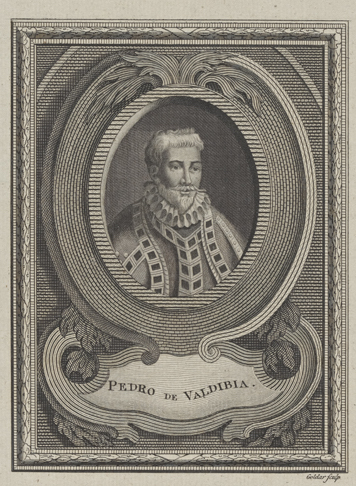
Spanish Conquistador Pedro de Valdivia penned this letter September 4, 1645 to King Charles V during a second attempt to capture Chile. The first attempt by Valdivia’s rival Diego de Almagro failed, which Pedro de Valdivia makes well-known in his letter, often superiorly comparing his attempts to those of Almagro. Born to a prominent family in Spain, Valdivia’s military career brought him to South America. Alongside other conquistadores, he first fought in the conquest of Peru. Similar to other conquistadores, Pedro de Valdivia enjoyed the spoils of war, but desired more. In 1640, Pedro de Valdivia asked and received permission from Francisco Pizarro to go to Chile. However, conquering lands was not an easy task so in 1545 Pedro de Valdivia sent a petition asking for additional royal support, specifically in the form of money.
To persuade the king, Valdivia speaks of his sacrifices and suffering. He recounts his personal sacrifices, much greater in comparison to Almagro. Valdivia makes perhaps one of the harshest accusations to a fellow conquistador in emphasizing what Valdivia believes to be Almagro’s “desertion.” In contrast, Valdivia has spent all of his possessions for this cause and his team has suffered from hunger and war. With the wars against the indigenous, Valdivia is careful in his language by stating that the indigenous rebelled and that the Spanish had to defend themselves. Valdivia also employs the influence and persuasive power of religion as he repeatedly refers to his team as Christians. Valdivia uses the fighting and death of Christians to further build his case while asking for the protection of God and the king throughout the construction of Christian settlements.
Valdivia’s letter is typical of those from conquistadores to the king in highlighting their request for royal support. The letter highlights many of the common elements of the conquering in the New World: wars with the indigenous groups, conquering in the name of the royal kingdom, spreading Christianity, and gaining both collective and personal wealth and prestige.
Works Cited:
Hutchison, Elizabeth Q., Thomas Miller Klubock, Nara B. Milanich, and Peter Winn, eds. The Chile Reader: History, Culture, Politics. Latin America Readers. Durham: Duke University Press, 2014.
Memoria Chilena: Portal. “Pedro de Valdivia (ca. 1500-1553) – Memoria Chilena.” Accessed January 28, 2020. http://www.memoriachilena.gob.cl/602/w3-article-767.html.
The Miriam and Ira D. Wallach Division of Art, Prints and Photographs: Print Collection, The New York Public Library. “Pedro de Valdivia” New York Public Library Digital Collections. Accessed February 3, 2020. http://digitalcollections.nypl.org/items/aebd7490-ddb6-0130-3fd4-58d385a7bbd0
Created by Emily Beuter
